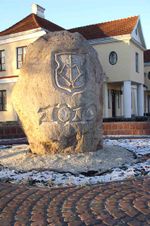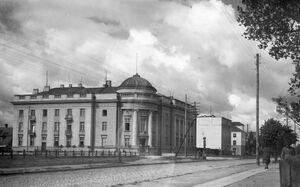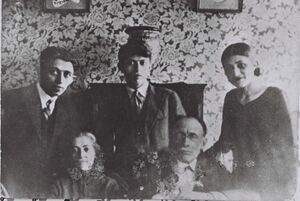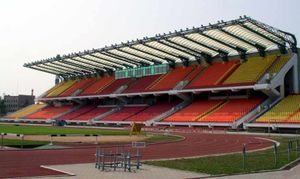برست، بلاروس
برست
Брэст / Брест | |
|---|---|
 المركز التجاري | |
| الإحداثيات: 52°08′N 23°40′E / 52.133°N 23.667°E | |
| البلد | |
| ڤوبلاست | ڤوبلاست برست |
| رايون | رايون برست |
| تأسست | 1019 |
| الحكومة | |
| • رئيس مجلس مدينة برست | Alexander Rogachuk [2] |
| المساحة | |
| • الإجمالي | 145 كم² (56 ميل²) |
| المنسوب | 280٫4 m (919٫9 ft) |
| التعداد (2014) | |
| • الإجمالي | 330٬934[1] ▲ |
| منطقة التوقيت | UTC+2 (EET) |
| • الصيف (التوقيت الصيفي) | UTC+3 (EEST) |
| Postal code | 224000 |
| مفتاح الهاتف | +375 (0)162 |
| License plate | 1 |
| الموقع الإلكتروني | Official website |
برست (بالبيلاروسية: [Брэст برِست] Error: {{Lang}}: text has italic markup (help)؛ إنگليزية: Brest أو تقليدياً Берасце, Bieraście؛ [Брест Brest] Error: {{Lang-xx}}: text has italic markup (help)؛ لتوانية: Brestas، والاسم المبكر Lietuvos Brasta (حرفياً، 'المخاضة اللتوانية')؛ پولندية: Brześć؛ اوكرانية: [Брест Brest] Error: {{Lang}}: text has italic markup (help), تقليدياً Берестя Berestia؛ باليديشية: בריסק Brisk)، وسابقاً أيضاً برست على البوگ و Brest-Litovsk ("Брэст-Лiтоўск" بالبلاروسية، حرفياً "برست اللتوانية")، هي مدينة (تعدادها 310,800 في سنة 2010) في بلاروس على الحدود مع پولندا مقابل المدينة الپولندية ترسپول Terespol، حيث يلتقي نهرا بوگ وموخاڤتس. وهي عاصمة ڤوبلاست برست.
مدينة برست هي موقع تاريخي للعديد من الحضارات. ففيها تم ابرام وثائق تاريخية هامة مثل اتحاد برست و معاهدة برست-لتوڤسك. حصن المدينة سماه الاتحاد السوڤيتي حصن بطل، وهي جائزة فريدة.
المدينة، أثناء العصور الوسطى، كانت جزءاً من مملكة پولندا من القرن العاشر حتى 1319 حين استولت عليها دوقية لتوانيا العظمى حتى تقسيم پولندا، حين أصبحت جزءاً من الامبراطورية الروسية في 1795. بعد الحرب العالمية الأولى، عادت المدينة مرة أخرى لپولندا ذات السيادة. وأثناء الحرب العالمية الثانية استولى على المدينة في بادئ الأمر السوڤيت وفي 1941 النازي. وبعد الحرب، مع الحدود الجديدة للاتحاد السوڤيتي مع پولندا، أصبحت المدينة جزءاً من جمهورية بلاروسيا الاشتراكية السوڤيتية حتى تفتت البلد في 1991، حيث أصبحت المدينة في حوذة بلاروس، حيث تبقى حتى اليوم.
اسم المدينة
There are several theories of the city name origin. The most common are as follows. The name of the city might have come from the Slavic root beresta meaning birch، أو لحاء. The name of the city could also originate from the Slavic root berest تعني elm. وأخيراً، قد ينحدر اسم المدينة من الكلمة اللتوانية brasta وتعني مخاضة.[3]
وكانت في وقت مركزاً للدراسات اليهودية، واسم المدينة باليديشية هو בריסק ("Brisk"), hence the term "Brisker" used to describe followers of the influential Soloveitchik family of rabbis. الاسم الأوكراني التقليدي للمدينة هو 'Берестя' (transliterated Berestia).
الاسم الپولندي للمدينة هو Brześć، وتاريخياً كان الاسم Brześć Litewski قبل تقسيم پولندا. وفي الجمهورية الپولندية الثانية أصبح اسم المدينة Brześć nad Bugiem (برست على البوگ) في 20 مارس 1923.[4]
The coat of arms features an arrow pointed upwards and a bow on a sky blue shield. It was adopted on January 26, 1991. Alternative coat of arms has a red shield, the first coat of arms of Brest was given by king Sigismund II Augustus in 1554.
التاريخ
As a town, Brest – Berestye in Kievan Rus – was first mentioned in the Primary Chronicle in 1019 when the Kievan Rus' took the stronghold from the Poles. It is one of the oldest cities in Belarus.[5] It was hotly contested between the Polish rulers (kings, principal dukes and dukes of Masovia) and Kievan Rus princes. It was recaptured by Poland in 1020, and unsuccessfully besieged by Prince Yaroslav the Wise of Kiev in 1022. It was captured Yaroslav the Wise, according to various sources, either in 1042[6] or 1044,[7] then by 1076 recaptured by King Bolesław II the Bold of Poland,[7] but then lost again by his successor Władysław I Herman. Afterwards, it often passed between the principalities of Turov and Volhynia.[6] In 1164, it was briefly captured by Lithuanians.[6] In 1178, it was captured by Casimir II the Just of Poland, and made the seat of his fraternal nephew Leszek, Duke of Masovia, who, however, soon lost it to the Principality of Minsk. In 1182, Casimir II the Just captured the city once again,[6][7] and then granted it as a fief to his sororal nephew Roman the Great the following year. It was laid waste by the Mongols in 1241 (see: First Mongol invasion of Poland), and was not rebuilt until 1275. Possibly since the 1270s, the city was contested by the Grand Duchy of Lithuania and the Kingdom of Galicia–Volhynia.[8]
Grand Duchy of Lithuania
In 1319, the city became part of the Grand Duchy of Lithuania, and Grand Duke Gediminas stayed in the city in the winter of 1319–1320, preparing to capture Kyiv.[7][9] In 1349, it was captured by King Casimir III of Poland, however, it was restored to Lithuania in 1352.[10] Its suburbs were burned by the Teutonic Order in 1379. In 1385, it became part of the Polish–Lithuanian union. During the Lithuanian Civil War (1389–1392), in 1390, the city was captured by Polish forces of Władysław II Jagiełło.[11]
In 1390 Brest became the first city in the lands that now are Belarus to receive Magdeburg rights.
In 1409 it was a meeting place of King Władysław II Jagiełło, Grand Duke Vytautas the Great and Khan Jalal al-Din Khan ibn Tokhtamysh under the Polish Deputy Chancellor Mikołaj Trąba's initiative, to prepare for war with the Teutonic Knights, which resulted in the Tatars aiding Poland and Lithuania in the Battle of Grunwald the following year.[7][12][13] In 1410 the city mustered a cavalry banner that participated in the Polish-Lithuanian military victory at Grunwald.
In 1419 it became a seat of the starost in the newly created Trakai Voivodeship. Under Władysław II and Vytautas the city was significantly developed and granted privileges similar to those of the Polish city of Lublin.[7][14] In 1425, the city hosted a congress attended by Władysław II, Vytautas, dukes of Masovia and Polish and Lithuanian nobles.[15] In 1440, a Sejm of the Grand Duchy of Lithuania was held in the city, at which Casimir IV Jagiellon was chosen Grand Duke of Lithuania.[7][13] In 1446, a meeting of Casimir IV, King of Poland and Grand Duke of Lithuania, and Polish senators regarding the political affiliation of Volhynia took place in the city, and in 1454 Casimir IV met with Lithuanian nobility to convince them to participate in the Polish–Teutonic War on the side of Poland.[7][16]
Polish—Lithuanian Commonwealth
![]() Mongol Empire (1246–1319)
Mongol Empire (1246–1319)
![]() Grand Duchy of Lithuania (1319–1320)
Grand Duchy of Lithuania (1319–1320)
![]() Kingdom of Galicia–Volhynia (1320–1321)
Kingdom of Galicia–Volhynia (1320–1321)
![]() Grand Duchy of Lithuania (1321–1349)
Grand Duchy of Lithuania (1321–1349)
![]() Kingdom of Poland (1349–1351)
Kingdom of Poland (1349–1351)
![]() Grand Duchy of Lithuania (1351–1569)
Grand Duchy of Lithuania (1351–1569)
![]() Polish–Lithuanian Commonwealth (1569–1795)
Polish–Lithuanian Commonwealth (1569–1795)
![]() Russian Empire (1795–1812)
Russian Empire (1795–1812)
![]() French occupation (1812)
French occupation (1812)
![]() Russian Empire (1812–1915)
Russian Empire (1812–1915)
![]() German occupation (1915–1918)
German occupation (1915–1918)
![]() Second Polish Republic (1918–1919)
Second Polish Republic (1918–1919)
![]() SSR Byelorussia (1919)
SSR Byelorussia (1919)
![]() Second Polish Republic (1919–1939)
Second Polish Republic (1919–1939)
![]() Soviet occupation (1939–1941)
Soviet occupation (1939–1941)
![]() German occupation (1941–1944)
German occupation (1941–1944)
![]() Soviet occupation (1944–1945)
Soviet occupation (1944–1945)
![]() Soviet Union (1945–1991)
Soviet Union (1945–1991)
In 1500, it was burned again by Crimean Tatars. From 1513, the city was administratively located in the Podlaskie Voivodeship. In 1566, following the decree of Sigismund II Augustus, a new voivodeship was created – Brest Litovsk Voivodeship.
During the union of the Polish–Lithuanian Commonwealth and the Swedish Empire under king Sigismund III Vasa (Polish–Swedish union), diets were held there. In 1594 and 1596, it was the meeting-place of two remarkable councils of regional bishops of the Roman-Catholic Church and Eastern Orthodox Church. The 1596 council established the Uniate Church (also known as the Belarusian Greek Catholic Church in Belarus and Ukrainian Greek Catholic Church in Ukraine). A Sejm of the Polish–Lithuanian Commonwealth was held in the city in 1653.[17] A royal mint was founded in the city by King John II Casimir Vasa in 1665.
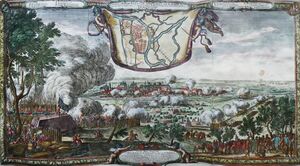
In 1657, and again in 1706, the town and castle were captured by the Swedish Army during its invasions of the Polish-Lithuanian Commonwealth. Then, in an attack from the other direction, on 13 January 1660, the invading Streltsy of the Tsardom of Russia under Ivan Andreyevich Khovansky took the Brest Castle in an early morning surprise attack, the town having been captured earlier, and massacred the 1,700 defenders and their families (according to an Austrian observer, Captain Rosestein).
Partitions
On 23 July 1792, the defending Grand Ducal Lithuanian Army, under the leadership of Szymon Zabiełło, and the invading Imperial Russian Army fought a battle near Brześć. On 19 September 1794, the area between Brest and Terespol was the site of another battle won by the Russian invaders led by Alexander Suvorov over a Polish-Lithuanian division under General Karol Sierakowski. Thereafter, Brest was annexed by Russia when the Poland-Lithuania Commonwealth was partitioned for the third time in 1795.
19th century to World War I
During Russian rule in the 19th century, Brest Fortress was built in and around the city. The Russians demolished the Polish Royal Castle and most Old Town "to make room" for the fortress.[بحاجة لمصدر] The main Jewish synagogue in the city, the Choral Synagogue, was completed c. 1862.
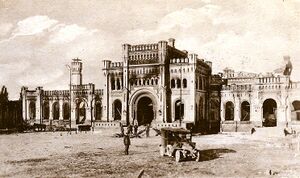
During World War I, the town was captured by the Imperial German Army under August von Mackensen on 25 August 1915, during the Great Retreat of 1915.[18] Shortly after Brest fell into German hands, war poet August Stramm, who has been called "the first of the Expressionists" and one of "the most innovative poets of the First World War,"[19] was shot in the head during an attack on nearby Russian positions on 1 September 1915.
In March 1918, in the Brest Fortress at the confluence of the Bug and Mukhavets rivers on the city' western outskirts, the Treaty of Brest-Litovsk was signed, ending the war between Soviet Russia and the Central Powers and transferring the city and its surrounding region to the sphere of influence of the German Empire. This treaty was subsequently annulled by the Paris Peace Conference treaties which ended the war and even more so by events and developments in Central and Eastern Europe. During 1918, the city became a part of the Podolia Governorate of the Ukrainian People's Republic as a result of negotiations and own treaty between the delegation of the Ukrainian Central Rada and Central Powers.[20]
Interwar Poland
On 9 February 1919, Polish troops entered the city, and it returned to Poland, which regained independence three months earlier.[21][22] During the Polish–Soviet War it was occupied by the Soviet Russians on 1 August 1920,[23] and recaptured by the Poles on 20 August,[21] with borders formally recognized by the Treaty of Riga of 1921. In 1921, it became the temporary capital of the Polesie Voivodeship instead of Pińsk.[24][25] It was renamed Brześć nad Bugiem (Brest on the Bug) on 20 March 1923.
The city was developed significantly and a number of representative public buildings were erected in Neoclassical and Modernist styles, especially at Ulica Unii Lubelskiej (Union of Lublin Street, now Lenin Street), including the Bank of Poland, Tax Chamber, Regional Chamber of the State Control, Healthcare Fund and Voivodeship Office.[26] Other notable projects include the officials' housing estate, stylistically inspired by historic manor houses of Polish nobility and the garden city movement, and the Warburg Residential Colony, dedicated to poor Jews who had lost their homes in World War I, founded by Felix M. Warburg, chairman of the Joint Distribution Committee of American Funds for Jewish War Sufferers.[27] In 1929, city limits were greatly expanded.[28][29]
In the twenty years of Poland's sovereignty, of the total of 36 brand new schools established in the city, there were ten public, and five private Jewish schools inaugurated, with Yiddish and Hebrew as the language of instruction. The first-ever Jewish school in Brześć history opened in 1920, almost immediately after Poland's return to independence. In 1936 Jews constituted 41.3% of the Brześć population or 21,518 citizens. Some 80.3% of private enterprises were run by Jews.[30][31][32] The Polish Army troops of the 9th Military District along with its headquarters were stationed in Brześć Fortress.
The city had an overwhelmingly Jewish population in the Russian Partition: 30,000 out of 45,000 total population according to Russian 1897 census, which fell to 21,000 out of 50,000 according to the Polish census of 1931.[33][34]
World War II

In early September 1939, the Polish government evacuated a portion of the Polish gold reserve from Warsaw to Brześć, and then further southeast to Śniatyn at the Poland-Romania border, from where it was transported via Romania and Turkey to territory controlled by Polish-allied France.[35]
During the German Invasion of Poland in 1939, the city was defended by a small garrison of four infantry battalions under General Konstanty Plisowski against General Heinz Guderian's XIX Panzer Corps. After four days of heavy fighting, the Polish forces withdrew southwards on 17 September. The Soviet invasion of Poland began on the same day. As a result, the Soviet Red Army entered the city at the end of September 1939 following the Molotov–Ribbentrop Pact's Secret Protocol, and a joint Nazi-Soviet military parade took place on 22 September 1939. While Belarusians consider it a reunification of the Belarusian nation under one constituency (the Byelorussian Soviet Socialist Republic at that time), Poles consider it the date when the city was lost. During the Soviet control (1939–41), the Polish population was subject to arrests, executions and mass deportations to Siberia and the Kazakh Soviet Socialist Republic. Many Poles were imprisoned in the local prison, and then moved to a prison in Minsk.[36] It is suspected that they were murdered by the Soviets in the Katyn massacre in 1940.[36]
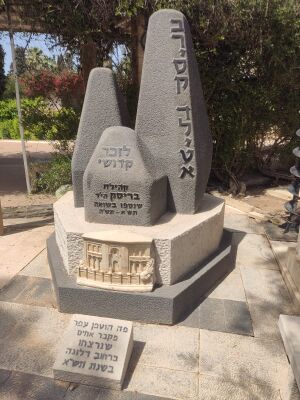
On 22 June 1941, Brest Fortress and the city were attacked by Nazi Germany on the first day of Operation Barbarossa, Nazi Germany's invasion of the Soviet Union. The fortress held out for six days. Nearly all its Soviet army defenders perished. The Germans placed Brest under the administration of the Reichskommissariat Ukraine. The remaining municipal Jewish population (about 20,000) was sequestered in the Brest ghetto established by the German authorities in December 1941 and later murdered in October 1942. Only seven Jews survived the Nazi executions.[34]
The Germans also operated a Nazi prison, a forced labour "education" camp for men and women, a forced labour camp for Jews, the AGSSt 3 prisoner-of-war assembly center, the Dulag 314 transit POW camp for Italians, the Stalag 397 POW camp for Soviet POWs and a subcamp of the Stalag 360 POW camp in the city.[37][38][39][40]
The Polish resistance movement, including the Polesie District of the Home Army, was active in the city.
The city was re-occupied by the Red Army on 28 July 1944, and eventually annexed from Poland the following year.
Post-war period
In 1945, the Związek Obrońców Wolności ("Freedom Defenders Association") Polish resistance organization was founded in the city, with its activities including secret Polish schooling, rescuing historical Polish monuments from devastation and organising aid for repressed people and those in a difficult material situation.[41] The organization was crushed by the NKVD in 1948, and its members were deported to Gulag forced labour camps for 25 years.[41]
In early 2019, a mass grave containing the remains of 1,214 people were found in the Brest Ghetto area during a construction project. Most are believed to have been Jews murdered by Nazis.[42][43]
المناخ
| بيانات المناخ لـ برست | |||||||||||||
|---|---|---|---|---|---|---|---|---|---|---|---|---|---|
| الشهر | ينا | فب | مار | أبر | ماي | يون | يول | أغس | سبت | أكت | نوف | ديس | السنة |
| القصوى القياسية °س (°ف) | 11.6 (52.9) |
17.2 (63.0) |
22.6 (72.7) |
30.7 (87.3) |
32.1 (89.8) |
33.0 (91.4) |
36.6 (97.9) |
35.6 (96.1) |
31.5 (88.7) |
26.4 (79.5) |
19.0 (66.2) |
14.5 (58.1) |
36.6 (97.9) |
| متوسط القصوى اليومية °س (°ف) | −0.1 (31.8) |
1.2 (34.2) |
6.3 (43.3) |
14.0 (57.2) |
20.1 (68.2) |
22.6 (72.7) |
24.9 (76.8) |
24.2 (75.6) |
18.4 (65.1) |
12.5 (54.5) |
5.4 (41.7) |
0.9 (33.6) |
12.5 (54.5) |
| المتوسط اليومي °س (°ف) | −2.6 (27.3) |
−1.9 (28.6) |
2.2 (36.0) |
8.7 (47.7) |
14.5 (58.1) |
17.1 (62.8) |
19.3 (66.7) |
18.5 (65.3) |
13.3 (55.9) |
8.3 (46.9) |
2.7 (36.9) |
−1.3 (29.7) |
8.2 (46.8) |
| متوسط الدنيا اليومية °س (°ف) | −4.9 (23.2) |
−4.5 (23.9) |
−1.2 (29.8) |
3.8 (38.8) |
9.0 (48.2) |
12.0 (53.6) |
14.2 (57.6) |
13.3 (55.9) |
9.1 (48.4) |
4.8 (40.6) |
0.4 (32.7) |
−3.5 (25.7) |
4.4 (39.9) |
| الصغرى القياسية °س (°ف) | −35.5 (−31.9) |
−28.1 (−18.6) |
−22.6 (−8.7) |
−6.2 (20.8) |
−4.2 (24.4) |
2.1 (35.8) |
5.8 (42.4) |
1.3 (34.3) |
−2.8 (27.0) |
−9.9 (14.2) |
−19.2 (−2.6) |
−25.1 (−13.2) |
−35.5 (−31.9) |
| متوسط تساقط الأمطار mm (inches) | 34 (1.3) |
33 (1.3) |
33 (1.3) |
37 (1.5) |
63 (2.5) |
68 (2.7) |
76 (3.0) |
72 (2.8) |
55 (2.2) |
37 (1.5) |
42 (1.7) |
41 (1.6) |
591 (23.3) |
| Average rainy days | 11 | 9 | 12 | 12 | 16 | 16 | 16 | 12 | 15 | 14 | 14 | 13 | 160 |
| متوسط الرطوبة النسبية (%) | 85 | 82 | 75 | 66 | 66 | 69 | 70 | 71 | 78 | 81 | 86 | 87 | 76 |
| Mean monthly ساعات سطوع الشمس | 50 | 70 | 133 | 176 | 238 | 248 | 259 | 242 | 170 | 114 | 46 | 32 | 1٬778 |
| Source 1: Pogoda.ru.net[44] | |||||||||||||
| Source 2: NOAA (sun, 1961–1990)[45] | |||||||||||||
معالم برست
بلدات توأم — مدن شقيقة
|
|
|
تكريم
A minor planet 3232 Brest, discovered by the Soviet astronomer Lyudmila Ivanovna Chernykh in 1974, is named after the city.[51]
أشخاص
- Menachem Begin, late Prime Minister of Israel
- Anabela Belikova, fashion model
- Jarosław Dąbrowski, Polish revolutionary and general
انظر أيضاً
Notes
- ^ "Belarus-The regions of the Republic of Belarus as well as all cities and urban settlements of more than 10,000 inhabitants". City Population. Retrieved 2014-04-11.
- ^ Alexander Lukashenko makes new appointments - The Official Internet Portal of the President of the Republic of Belarus. 14 October 2014
- ^ Encyclopedia Lituanica. Boston, Massachusetts, Vol. I, p.409. LCC74-114275
- ^ Kancelaria Sejmu RP (2013), Dz.U. 1923 nr 39 poz. 269 ISAP Archive. Link to PDF document.
- ^ "Brest as a tourist destination – private Minsk tours". 20 June 2011. Archived from the original on 18 March 2015. Retrieved 13 March 2015.
- ^ أ ب ت ث Mondalski 1929, p. 43.
- ^ أ ب ت ث ج ح خ د Słownik geograficzny Królestwa Polskiego i innych krajów słowiańskich, Tom I (in البولندية). Warszawa. 1880. p. 399.
{{cite book}}: CS1 maint: location missing publisher (link) - ^ Halecki, Oskar (2013). Dzieje Unii Jagiellońskiej. Tom I. W wiekach średnich (in البولندية). Warszawa: Instytut Historyczny Uniwersytetu Warszawskiego, Wydawnictwo Neriton. p. 46. ISBN 978-83-7543-277-0.
- ^ Mondalski 1929, p. 47.
- ^ Halecki, p. 71
- ^ Halecki, Oskar (2013). Dzieje Unii Jagiellońskiej. Tom I. W wiekach średnich (in البولندية). Warszawa: Instytut Historyczny Uniwersytetu Warszawskiego, Wydawnictwo Neriton. pp. 133–134. ISBN 978-83-7543-277-0.
- ^ Halecki, p. 190
- ^ أ ب Mondalski 1929, p. 53.
- ^ Mondalski 1929, pp. 51, 53.
- ^ Halecki, p. 229
- ^ Mondalski 1929, pp. 53, 55.
- ^ Konopczyński, Władysław (1948). Chronologia sejmów polskich 1493–1793 (in البولندية). Kraków: Polska Akademia Umiejętności. p. 153.
- ^ Robson, Stuart (2007). The First World War (in الإنجليزية) (1 ed.). Harrow, England: Pearson Longman. p. 30. ISBN 978-1-4058-2471-2 – via Archive Foundation.
- ^ Tim Cross (1988) The Lost Voices of World War I, page 124.
- ^ Ivan Katchanovski; Zenon E., Kohut; Bohdan Y., Nebesio; Myroslav, Yurkevich (2013). Historical Dictionary of Ukraine. Scarecrow Press. pp. 60–61. ISBN 9780810878471.
- ^ أ ب Mondalski 1929, p. 96.
- ^ Pszczółkowski 2014, p. 6.
- ^ Pszczółkowski 2014, pp. 6–7.
- ^ Pszczółkowski 2014, p. 7.
- ^ Mondalski 1929, p. 97.
- ^ Pszczółkowski 2014, pp. 13, 15, 17, 29-30.
- ^ Pszczółkowski 2014, pp. 18-21, 30-32.
- ^ قالب:Cite Polish law
- ^ Pszczółkowski 2014, p. 9.
- ^ Norman Davies, God's Playground (Polish edition), Second volume, p.512-513
- ^ Alice Teichova; Herbert Matis; Jaroslav Pátek (2000). Economic Change and the National Question in Twentieth-century Europe. Cambridge University Press. pp. 342–344. ISBN 978-0-521-63037-5.
- ^ Stosunki polsko-białoruskie pod okupacją sowiecką, (Polish-Byelorussian relations under the Soviet occupation). Bialorus.pl (in پولندية)
- ^ Joshua D. Zimmerman, Poles, Jews, and the politics of nationality, University of Wisconsin Press, 2004, ISBN 0-299-19464-7, Google Print, p.16
- ^ أ ب Christopher R. Browning, Nazi policy, Jewish workers, German killers', Google Print, p.124
- ^ Wróbel, Janusz (2002). "Wojenne losy polskiego złota". Biuletyn Instytutu Pamięci Narodowej (in البولندية). No. 8-9 (19-20). IPN. pp. 55–58. ISSN 1641-9561.
- ^ أ ب Ziółkowska, Ewa (2009). "Kuropaty". Biuletyn Instytutu Pamięci Narodowej (in البولندية). No. 1–2 (96–97). IPN. p. 51. ISSN 1641-9561.
- ^ "Gefängnis Brest-Litowsk". Bundesarchiv.de (in الألمانية). Retrieved 30 September 2023.
- ^ "Arbeitserziehungslager Brest". Bundesarchiv.de (in الألمانية). Retrieved 30 September 2023.
- ^ "Zwangsarbeitslager für Juden Brest". Bundesarchiv.de (in الألمانية). Retrieved 30 September 2023.
- ^ Megargee, Geoffrey P.; Overmans, Rüdiger; Vogt, Wolfgang (2022). The United States Holocaust Memorial Museum Encyclopedia of Camps and Ghettos 1933–1945. Volume IV. Indiana University Press, United States Holocaust Memorial Museum. pp. 39, 117, 363, 385–386. ISBN 978-0-253-06089-1.
- ^ أ ب Krajewski, Kazimierz; Łabuszewski, Tomasz (2009). "Ostatni obrońcy Kresow Połnocno-Wschodnich". Biuletyn Instytutu Pamięci Narodowej (in البولندية). No. 1–2 (96–97). IPN. pp. 105–106. ISSN 1641-9561.
- ^ Liphshiz, Cnaan (22 February 2019). "Remains of Hundreds of Bodies Unearthed at Former Jewish Ghetto in Belarus". The Jerusalem Post. Jewish Telegraphic Agency. Archived from the original on 28 February 2019. Retrieved 28 February 2019.
{{cite news}}: CS1 maint: bot: original URL status unknown (link) - ^ Higgins, Andrew (27 April 2019). "Belarus Building Site Yields the Bones of 1,214 Holocaust Victims". New York Times. Archived from the original on 12 May 2021. Retrieved 11 June 2021.
{{cite web}}: CS1 maint: bot: original URL status unknown (link) - ^ "Weather and Climate- The Climate of Brest" (in Russian). Weather and Climate (Погода и климат). Retrieved 15 May 2015.
{{cite web}}: CS1 maint: unrecognized language (link) - ^ "Brest Climate Normals 1961–1990". National Oceanic and Atmospheric Administration. Retrieved 15 May 2015.
- ^ Побратимские связи г. Бреста. city.brest.by (in Russian). Retrieved 8 March 2010.
{{cite web}}: CS1 maint: unrecognized language (link) - ^ Офіційний сайт міста Івано-Франківська. mvk.if.ua (in Ukrainian). Retrieved 7 March 2010.
{{cite web}}: CS1 maint: unrecognized language (link) - ^ "Miasta Partnerskie Lublina". Urząd Miasta Lublin [City of Lublin] (in Polish). Archived from the original on 2013-01-16. Retrieved 2013-08-07.
{{cite web}}: External link in|work=|trans_title=ignored (|trans-title=suggested) (help)CS1 maint: unrecognized language (link) - ^ "Embassy of the Republic of Belarus in the Kingdom of the Netherlands - News of the Embassy". Netherlands.mfa.gov.by. 2011-05-16. Retrieved 2013-03-26.
- ^ "Georgia's Batumi and Belarus' Brest become twin cities". Agenda.ge. 24 April 2015. Retrieved 26 May 2015.
- ^ Dictionary of Minor Planet Names – p.269
وصلات خارجية
- Pages using gadget WikiMiniAtlas
- CS1 maint: location missing publisher
- CS1 البولندية-language sources (pl)
- Articles with پولندية-language sources (pl)
- CS1 الألمانية-language sources (de)
- CS1 maint: bot: original URL status unknown
- CS1 uses الروسية-language script (ru)
- CS1 uses الأوكرانية-language script (uk)
- CS1 errors: unsupported parameter
- Short description is different from Wikidata
- Coordinates on Wikidata
- Pages using infobox settlement with unknown parameters
- Lang and lang-xx template errors
- Articles containing إنگليزية-language text
- Pages using Lang-xx templates
- Articles containing لتوانية-language text
- Articles containing پولندية-language text
- Articles containing يديشية-language text
- Articles with unsourced statements from October 2012
- Articles with hatnote templates targeting a nonexistent page
- Brest, Belarus
- Archaeological sites in Belarus
- Belarus–Poland border crossings
- مدن بلاروس
- محافظة گرودنو
- ڤويڤودية پولسي
- ڤويڤودية برست لتوڤسك
- أماكن مأهولة تأسست في القرن 11
- أماكن مأهولة في منطقة برست
- تأسيسات القرن 11 في أوروپا



